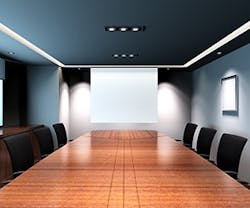5 Elements Your Conference Room Display Should Have
Choosing a display device for your conference room has come a long way since the days of slide projectors. With options such as dedicated business projectors, consumer flat panels and commercial-grade flat panels, it can be hard to make a decision. Epson America has shared 5 key tips that can help you provide the best projection experience while staying within budget.
1) Readability: Presentations and projects meant to be displayed should be able to be read from any position in the room. Before making a decision, be sure to sit in the room in the farthest position away from the screen to ensure that all participants will be able to read the display. This is especially relevant if your occupants use carefully formatted information, such as in a spreadsheet or a presentation.
2) Connectivity: Determine what types of connectivity your occupants will need. Though they can be less expensive, some consumer flat panel displays do not offer the advanced connectivity options that commercial-grade models and business projectors do. If your occupants need connectivity to VGA, USB, HDMI, or even wireless, be sure to confirm that the display type you choose includes the functionality your occupants need.
3) Resolution: Don’t get stuck with a grainy image your occupants have to strain their eyes to see. With the multitude of devices today’s business people use, be sure that the device you’ve chosen has been designed to easily sync with computers, tablets and smartphones.
4) Portability: In today’s hectic working environment, consider whether or not your display will be permanently installed or will need to be moved between rooms. Flat panel displays, while tending to be less expensive, can be a hassle if you have multiple conference rooms which need to be outfitted. If your display needs to be mobile, choosing a business projector which can be moved or placed wherever is convenient could be your best option – you may not even need a screen – just project directly onto the wall or a whiteboard.
5) Features: From video conferencing to the size of your display relative to your conference room, features can make or break your display decision. Many displays and even projectors include split screen functionality, which can allow users to see both people and content simultaneously. If your conference room is relatively small, one option to consider is a short-throw projector, some of which can display as large as 100-inches diagonal while being placed just inches from the wall.
“Most people associate projectors with large meeting rooms, however projectors are an excellent solution for small and medium rooms as well,” says Claudine Wolas Shiva, senior marketing manager, Projectors, Epson America, Inc. The right projection solution should include the essential elements for a meeting space – large display size, high image quality, connectivity options, and ease of use.
